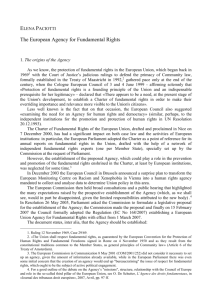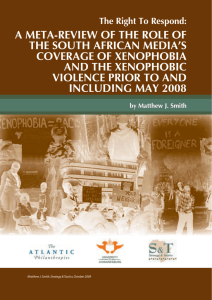Theoretical Considerations of Xenophobia
advertisement
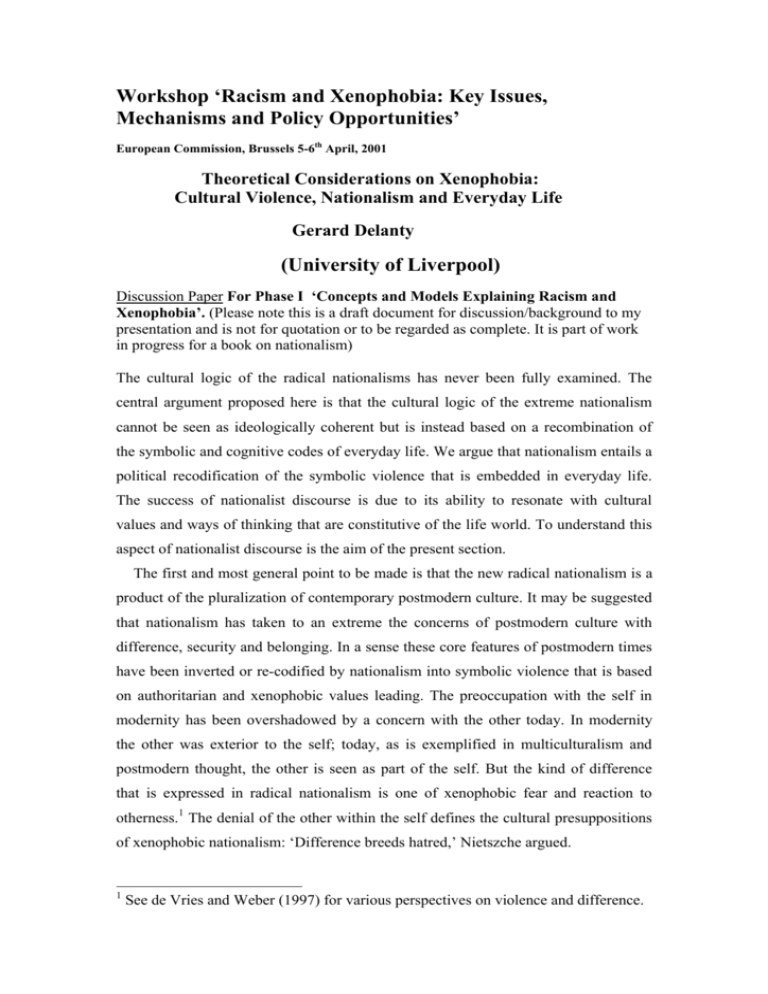
Workshop ‘Racism and Xenophobia: Key Issues, Mechanisms and Policy Opportunities’ European Commission, Brussels 5-6th April, 2001 Theoretical Considerations on Xenophobia: Cultural Violence, Nationalism and Everyday Life Gerard Delanty (University of Liverpool) Discussion Paper For Phase I ‘Concepts and Models Explaining Racism and Xenophobia’. (Please note this is a draft document for discussion/background to my presentation and is not for quotation or to be regarded as complete. It is part of work in progress for a book on nationalism) The cultural logic of the radical nationalisms has never been fully examined. The central argument proposed here is that the cultural logic of the extreme nationalism cannot be seen as ideologically coherent but is instead based on a recombination of the symbolic and cognitive codes of everyday life. We argue that nationalism entails a political recodification of the symbolic violence that is embedded in everyday life. The success of nationalist discourse is due to its ability to resonate with cultural values and ways of thinking that are constitutive of the life world. To understand this aspect of nationalist discourse is the aim of the present section. The first and most general point to be made is that the new radical nationalism is a product of the pluralization of contemporary postmodern culture. It may be suggested that nationalism has taken to an extreme the concerns of postmodern culture with difference, security and belonging. In a sense these core features of postmodern times have been inverted or re-codified by nationalism into symbolic violence that is based on authoritarian and xenophobic values leading. The preoccupation with the self in modernity has been overshadowed by a concern with the other today. In modernity the other was exterior to the self; today, as is exemplified in multiculturalism and postmodern thought, the other is seen as part of the self. But the kind of difference that is expressed in radical nationalism is one of xenophobic fear and reaction to otherness.1 The denial of the other within the self defines the cultural presuppositions of xenophobic nationalism: ‘Difference breeds hatred,’ Nietszche argued. 1 See de Vries and Weber (1997) for various perspectives on violence and difference. We should not see xenophobia as an irrational and therefore an inexplicable psycho-social disposition.2 Hatred of the other does not explain very much. The term is often used, to mean hatred as opposed to fear of otherness (the stranger, foreigners). But there are major differences between hatred and fear as psycho-social dispositions. Fear may lead to hatred but hatred may not lead to fear. Hostility is a term that is also used to suggest something between outright hatred and fear. Moreover, xenophobia is not the same as racism or fascism. Racism is much more explicitly an extreme hatred of particular races and is based on a cultural and ideological theory of the biological superiority of the self over the other. Fascism is not primarily an ideology about otherness, and in its classic form in Italian fascism the preoccupation with minorities or other national groups was relatively minor. Indeed, anti-Semitism was marginal in the case of Italian fascism. Fascism is primarily a political ideology of absolute loyalty to the national state. These distinctions are important to make, particularly in the context of radical nationalism since its presuppositions are not primarily about race or about hatred. The strict meaning of xenophobia, literally fear of the other, should be retained and distinguished from other and related dispositions. This is because, as will be shortly demonstrated, the xenophobic component of nationalist discourse is more about fear of the other within the self than hatred and in most of its expressions explicit racism is not evident. We thus making the strong argument that radical nationalism is primarily driven by xenophobia and not by racism or fascism or even as something as vague and ill-defined as ethnocentrism. The implication of this view is that xeonophobia while often being a basis of racism is quite distinct from racism. Indeed, many of the historical forms of racism did not emanate from xenophobia but from science. What then is xenophobia? Xenophobia is rooted in the symbolic violence of everyday life from where it derives its primary motivations, but is also linked to the symbolic violence in cultural worldviews from where it derives legitimation. Distinguishing then between the level of everyday motivations within the life world and cultural legitimations, we can discuss the cultural logic of radical nationalism in the following way. The primary motivational sources of xenophobia that derive from everyday life can be resentment, disappointment, anxiety and uncertainty, and cultural trauma. 2 Hatred is often used as a vague term that is rarely theorized sociologically, as in Hockenos (1993). Resentment is one of the main expressions of hostility against others and which can be expressed in the more overt form of xenophobia but is more fundamentally a feature of modern life. Nietzsche in the Genealogy of Morals regarded resentment as deeply embedded in modern culture, an expression of a powerful reactive current in modernity. It is an opposition to the other within the self and to the other outside the self. In either case it is an attitude that constructs self-identity through negative identity. In order to exist the ‘slave morality’ requires an other to provide the reference point for the identity of the self.3 Greenfeld and Chirot have also noted the role of ressentiment in non-western nationalism, which while taking over western Enlightenment ideas and practices developed at the same time a deeply rooted ressentiment of those values and which often became the basis of later xenophobia and agression (Greenfeld and Chirot, 1994, pp.102-124). Disappointment as a result of the disjuncture between expectations and experience is another source of xenophobia. Disappointment with the promises of modernity has led many voters into supporting political causes that have projected guilt onto a scapegoat, such as a national minority or ethnic group that may be associated with an external community. This might explain how revolutions of rising expectations have often been transformed into reactionary nationalist movements. Several studies of extreme right-wing voting in the western Europe in the 1990s, emphasize the role of protest rather than right-wing ideology. It would appear that dissatisfaction with democracy more than right-wing ideology is what is significant (Falter and Klein, 1996, p. 53). However, there is general agreement that some ideological predispositions are required for dissatisfaction to play a major role in extreme right wing voting. Anxiety and uncertainty also play a role in shaping the conditions that a conducive to xenophobia. Cultural trauma is a more pronounced kind of anxiety that arises as a result of a total break-down in the social order that leads to a ‘cultural shock’ (Neal, (1998); Sztompka, 2000). One of the consequences of cultural trauma is a culture of distrust which can easily be conducive to xenophobia and inter-group violence. However, xenophobia can be linked to more explicit forms of symbolic violence which have a more pronounced legitimating function in maintaining otherness and in maintaining adversarial frames. Examples of these might include (a) racism, (b) anti3 For Max Scheler in a philosophical work, Ressentiment, published in 1915, semitism, (c) homophobia (d) misogyny (e) citizenship and nationality, (f) moral purity, (g) ethnocentrism, (h) exoticism. On these levels otherness is expressed in more objectivist terms than in the symbolic violence of the habitus, where the otherness of the ‘they’ is subordinated to the identity of the ‘we’. This in the case of racism and anti-Semitism, which are more than forms of prejudice that may arise from ignorance or fear, but are ideologically and often theoretically elaborated. Homophobia and misogyny are forms of hatred that are nourished by some of the cultural practices of everyday life, such as sexism and patriarchy. Citizenship itself makes a fundamental distinction between citizens and aliens, and as such offers a weak cultural basis of exclusion (Mann, 1997). Ethnocentricism is more present in some cultural forms than in others, depending on the relationship between cultural and political identities. If the political identity of the state rests on a prior cultural identity which is primarily defined by ethnic, primordial codes, the cultural identity is likely to exhibit a high degree of ethnocentrism. Moral purity can be a consequence of ethnocentrism, as Barrington Moore has argued (Moore, 2000). Exoticism may also be mentioned as a relatively weak cultural basis of otherness, and this can also be related to the role of fantas (Todorov, 1993; Salecl, 1993). To separate symbolic violence that is expressed in the new radical nationalism into two levels, a strong and a weak level, allows us trace the relations between the social and cultural sides in a more intricate manner and in way that avoids conflations of its different dimensions. This involves distinguishing two levels of symbolic violence; one the level of everyday life (i.e. social practices) and on the cognitive level of cultural narratives, codes, adversarial and symbolic codes. In contrast to Johan Galtung’s well known concept of cultural violence as a form of violence that is embedded in culture as opposed to the structural violence in institutions, we see cultural violence as more differentiated (Galtung, 1990). For Galtung cultural violence relates to those aspects of culture that are exemplified by religion, ideology, language, art and even science and which may indirectly legitimate violence. This neglects the more subtle and less coherent dimension of symbolic violence in the practices that constitute habitus, where it may also provide an indirect basis for violence, but one that is less articulated than on the cultural level. ‘ressentment’ is the condition of modernity itself (Scheler, 1972). Symbolic violence is contained in everyday life in several cognitive frames and symbolic dispositions that express xenophobia or condusive to it. Fear of the other has arguably increased with modernity, which has brought strangeness into the heart of the life world through immigration, multiculturalism, consumption, tourism, education, and value pluralization. Fear of the other accompanies modernity’s logic of inclusion in the form of a construction of different order of exclusion, ranging from exotic fantasies to xenophobic neo-nazism (Theweliet, 1987). Xenophobia is shaped by the logic of exclusion – the separation of the ‘we’ from the ‘they’ - and the construction of adversarial frames, requiring a negative identification by which the ‘they’ becomes an enemy. Carl Schmitt (1970) generalized such relations of enmity to all of politics, which he believed was always about the fundamental division of ‘friends and enemies.’ But his reductionist philosophy failed to see that the us/them polarity is distinct from the quite different logic of xenophobic politics by which the ‘they’ becomes first an ‘other’ and then an enemy. However the shift from exclusion to adversity is a very subtle one. Most groups are based on a sense of the ‘we’ as distinct from a ‘them’. The potentiality for other-creating mechanisms to become adversarial is always present.4 For instance, a sense of grievance or an injustice can transform the self identity of the we into an exclusive preoccupation with the other who is made responsible for the fate of the we. The normal means of coping with this necessity for boundary maintenance against an enemy is punishment sanctioned by law and other civic norms of justice, but other mechanisms can be employed, such as denial (Cohen, 2001). Xenophobia results when the self loses its self-identity and seeks in the other the reference point for its identity. In such circumstances the other ceases to be an enemy as such, but a pathological expression of self-identity. Cultural codes of otherness can thus arise from the fundamental facts of group identity and can be sustained by adversarial codes which may involve xenophobic dimensions. However, not all adversarial frames become xenophobic, just as not all tightly defined we-groups become adversarial. Xenophobic relations result when the adversarial frames that maintain otherness are unable to maintain exclusion, or when the logic of inclusion and exclusion breaks down or becomes diffuse. The claim that is being made, then, is that xenophobic relations do not arise directly from the logic of exclusion and nor do they arise directly from adversarial frames. Such forms of 4 For an inspiring analysis of some of the mechanisms, see Gamson (1995). See also symbolic violence are, to varying degrees, normal. Xenophobia becomes a pronounced pathological force when adversarial frames arise and, crucially, are unable to maintain the fundamental boundaries of self and other. Xenophobia is thus the pathological condition that arises when the self is unable to cope with otherness and is destructive of both self and other. Thus, many forms of xenophobia result from situations where, becase of social and political change, the internal other becomes associated with an external other, as in the case of national minorities who become perceived as a threat due to their association with a larger group in a neighbouring state. Especially in situations where the other is so close to the self, the other is generally defined in reified codes and by the construction of a scapegoat, for instance, homosexuals.5 Theoretically, then, xenophobia can be understood as akin to the logic of reification, by which the other is a fetish for the self. Because of the latent symbolic violence that is inherent in group dynamics, many forms of nationalism are potentially xenophobic. In Karl Deutsch’s famous definition, xenophobia is written into the heart of nationalism: ‘A nation is a group of persons united by a common error about their ancestry and a common dislike of the neighbors’ (Deutsch, 1969, p. 3). In the extreme case it can lead to ethnic cleansing and ultimately to genocide. In this chapter we have argued for the need to appreciate the cultural logic by which symbolic violence in everyday life and in the habitus of the group can be made to serve adversarial frames on the cultural level and to distinguish both of these from the pathological condition of xenophobia. The implications of this is that extreme forms of nationalism feed off the xenophobia that is present in everyday life and in cultural codes. Nationalism is part of the global world and will not wither away along with the state, as a older social theory once believed. Ways of living with it will have to be found. In the next chapter we discuss prospects of accommodating nationalism and diffusing it of some of its violent dimensions. Address Professor Gerard Delanty, Department of Sociology, University of Liverpool, Eleanor Rathbone Building, Bedford Street South, University of Liverpool, Liverpool L69 7ZA, UK. Email: delanty@liverpool.ac.uk Rothchild and Groth (1995) and Wendt (1994). 55 This can be compared to what Freud called the narcissism of minor differences. See Blok (1998).
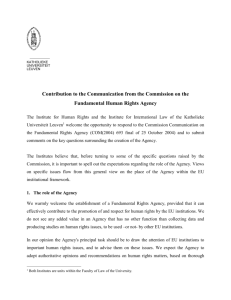


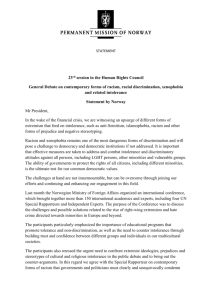
![“The Progress of invention is really a threat [to monarchy]. Whenever](http://s2.studylib.net/store/data/005328855_1-dcf2226918c1b7efad661cb19485529d-300x300.png)

